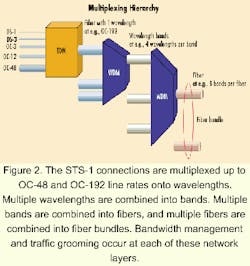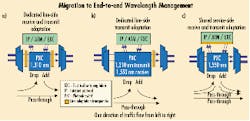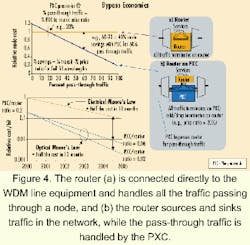Moving toward all-optical networks
A look at the emerging trends and technologies that will help shape future optical networks.
John Gruber and Rajiv Ramaswami
Nortel Networks
There are two important trends emerging in optical networks. The first trend is adding agility in the optical layer-moving from a dumb point-to-point network providing static fat pipes to an intelligent network providing dynamic end-to-end fat pipes on an as-needed, when-needed basis.
Key enablers of this evolution are a move from manual to semi-automatic provisioning and a migration from a management plane to a control plane for connection management.
The second trend is the move from an opaque network consisting of multiwavelength point-to-point links, each with electrical processing at their ends, to an all-optical network where traffic is managed end-to-end and mainly in the optical domain.
The first generation of optical networks employed primarily static point-to-point WDM systems to provide increased network capacity. Optical networks using WDM are now widely deployed in carrier networks, particularly in long-haul networks. For the most part, these point-to-point WDM systems provide tens of wavelengths worth of capacity over a single fiber pair, with each wavelength operating at OC-48 (2.5 Gbits/sec) or OC-192 (10 Gbits/sec). These networks were primarily statically configured with transponders and multiplexers, creating "dumb" optical pipes between locations.Next-generation optical networks are emerging, which use switching to provide dynamic end-to-end management of connections creating an intelligent optical network (ION). The ION provides rapid dynamic provisioning and restoration of end-to-end connections. A connection ranges from an STS-1 signal (51 Mbits/sec) up to an entire wavelength of capacity. This capability will profoundly change the nature of communications services and stimulate further growth in bandwidth usage. Operations costs will dramatically decrease, enabling carriers to offer services at less cost. Connections can be set up and taken down in seconds to minutes, enabling short-term contractual arrangements.
Optical networking is key to the ION, providing scalability, robustness, and lowest cost to the service layer.1 The optical layer consists of building blocks that, together with network intelligence, support an agile optical layer (see Figure 1). These building blocks include high-capacity line systems, optical-switching platforms, and tunable devices.
The high-capacity line systems can approach terabits per second rates and support long all-optical reach of a few thousand kilometers between end-city pairs. Since these systems have very few per-light-path electrical regenerator sites, they offer capital, operational, and service velocity advantages over conventional shorter-reach line systems.
The optical-switching platforms in the optical layer will migrate from opaque to all-optical over time, with unprecedented open-ended scalability via the ability to switch light paths, bands of light paths, or entire line-system fibers.2
Tunable sources, filters, and receivers will provide flexible selectivity, reduced inventory, and operations savings. These edge devices support efficient wavelength assignment and reduced wavelength blocking and address reach limitations through inherent regeneration. Tunable sources and receivers suitable for long-haul transmission may also become more integrated with client interfaces over time; these devices are now available at 2.5- and 10-Gbit/sec rates.
From a service provider's standpoint, the key drivers for photonic switches (PXCs) are scalability, cost reduction, and service velocity. These drivers accrue from the PXC's ability to transparently switch a wavelength of any rate and protocol, or a wavelength band, or an entire system fiber full of wavelengths-on a single PXC port.
From a technology standpoint, rapid advances are driving the introduction of photonic switches and all-optical-networking technologies. Long-reach optical systems capable of upwards of 3,000 km are almost ready for commercial deployment. Photonic-switch technology is maturing rapidly, with greater scalability and reliability. PXCs are also becoming more manageable, especially when used as a complement to an optical switch with electrical switching fabrics (EXCs). In addition, significant strides are being made at the control layer in terms of proposals in various public forums for control architectures and light-path signaling and routing protocols to enable flexible mesh networking for rapid connection setup and restoration.
In addition to the network elements needed in the ION, the remaining key element is management and control across all network elements. The control plane allows end-to-end connections to be set up, maintained, and taken down in an automated manner within seconds. Such a control plane allows carriers to use the ION to rapidly provision connections and deploy services where needed, when needed. The best way to implement such a control plane in the least time is to reuse or adapt protocols already available to perform similar functions in other networks such as the Internet.3,4,5,6,7 A control plane consists of several parts:
- A signaling channel to allow nodes to exchange control information. The best mechanism is an out-of-band signaling channel that provides several benefits. It allows a variety of different types of equipment to communicate-on the edge, that could include SONET, Internet Protocol (IP), ATM, Gigabit Ethernet, or Fibre Channel client platforms signaling into the network. In the optical layer, it could accommodate PXCs as well as opaque optical crossconnects (OXCs). An out-of-band signaling channel also allows as much bandwidth as needed for signaling. For example, if 10-Mbit/sec Ethernet isn't sufficient, an upgrade to 100 Mbit/sec or 1-Gigabit Ethernet is possible.
- A signaling protocol to enable nodes to rapidly set up and take down end-to-end connections. Existing signaling protocols such as RSVP or CR-LDP from the Internet world or SS7 from the telephone network can be used for this purpose.
- A topology database updated and maintained in a distributed fashion. Internet routing protocols such as open shortest path first can be extended to provide such functions.
- Flexible restoration mechanisms that make use of signaling and routing protocols to provide rapid connection restoration.
A management plane capable of provisioning and managing end-to-end connections complements the control plane. The management plane, consisting of element- and network-management systems, will continue to have a key role in centrally controlled point-and-click light-path provisioning, performance monitoring to verify service-level agreements, and fault detection and location to trigger repair processes. The management system also needs to include built-in network planning tools that enable carriers to plan and deploy network resources. Going forward, the control plane will complement the management plane with distributed signaling and routing protocols to enable client-driven light-path dialup for such new capabilities as time-of-day and event-driven services as well as mesh restoration options.
The core transport network provides bandwidth in granularities ranging from DS-3/STS-1 connections up to OC-192 light paths. Therefore, bandwidth management in the network needs to occur at several levels. Figure 2 shows a typical multiplexing hierarchy.
Today, private-line services provide a significant revenue for carriers. Most private-line traffic enters the network as DS-3s (or equivalent STS-1s). At the network edge, these STS-1s need to be groomed and multiplexed into OC-48, OC-192, or wavelengths. At intermediate nodes, some wavelengths may need demultiplexing to the STS-1 layer to extract individual STS-1 streams. Therefore, there clearly is a need for a network element that can groom traffic at the STS-1 layer.
Within the core of the network, traffic is managed primarily at the light-path level. With appropriate connection management, a significant amount of traffic at any node can be treated as express traffic-traffic that is passing through the node and does not need to be terminated locally. This traffic is best handled by network elements that manage traffic in wavelengths. With the huge increase in traffic at network transit nodes, there is also an increasing need to manage traffic in groups of wavelengths (bands) or even of entire system fibers.
The term "optical crossconnect" refers to network elements that are large-scale switches that provide traffic grooming at various layers. These OXCs can be realized using electronic switching or photonic switching. There are basically three types of OXCs:
- The purely photonic OXC (PXC) is capable of switching traffic as wavelengths, bands of wavelengths, or entire fibers, independent of the signal bit rate or protocol on each of the wavelengths. It is not suitable, however, for switching traffic at granularities below a wavelength.
- Another type of OXC has an electrical switching fabric operating at STS-1 granularity-labeled as EXC/1 to indicate grooming at the STS-1 rates. This OXC converts the optical signal into an electrical signal and demultiplexes it down to STS-1 levels before switching it internally. These OXCs are suitable for switching traffic as wavelengths or subwavelengths. From a switching perspective, these OXCs are the next generation of current broadband digital crossconnects. These devices are significantly denser, have built-in high-speed optical interfaces up to OC-192, and incorporate optical-layer provisioning and restoration mechanisms.
- A third type of OXC has an electrical switching fabric operating at 2.5 Gbits/sec. These OXCs switch and demultiplex traffic in units of 2.5 Gbits/sec. Such an OXC is labeled as an EXC/48 to indicate grooming at the STS-48 level. In terms of general network application, these OXCs are limited because they can switch OC-48 streams but without sub-rate grooming. Such OXCs are more customized for coarse granular (e.g., OC-48c) traffic, although, other types of OXCs can also support coarse granular traffic.
Considering general network applications, it is clear that an EXC/48 occupies a niche between the PXC and the EXC/1. The PXC is capable of performing a superset of EXC/48 functions because it can switch traffic in units of wavelengths, bands, or fibers and is insensitive to the actual bit rates of the signals. The EXC/1 also performs a superset of EXC/48 functions.
The cost of an EXC/1 or EXC/48 is dominated by optical-electrical conversions, with the cost of the switch fabric being relatively small in comparison. It is possible to achieve similar densities and footprints for both types of OXCs. A PXC is more cost-effective at grooming traffic at OC-192 rates or higher, or in bands of wavelengths or entire fibers. Therefore, it would seem that EXC/48s have a relatively small role to play in the core network over time.
The key elements in the all-optical network are WDM line systems, PXCs, EXC/1s, and IP routers. IP routers will likely end up sourcing most traffic in next-generation core networks. There are several configurations in which these network elements can be deployed.Figure 3. The transponder (a) converts a local non-WDM signal into a signal at an appropriate wavelength suitable for use in WDM line systems, using optical-electrical-optical (OEO) conversion to achieve this function. An EXC/1 (b) is equipped with receive wavelength-compatible optical interfaces that can be directly connected into the WDM line system without the need for separate transponders. A long-reach WDM line system (c) passes signals through at intermediate nodes in the optical domain, without requiring OEO conversions.
Figure 3 shows three different node configurations for managing traffic in the network. Figure 3a shows a WDM line terminal equipped with transponders. A transponder converts a local non-WDM signal into a signal at an appropriate wavelength suitable for use in WDM line systems. It uses an optical-electrical-optical (OEO) conversion to achieve this function. Transponders thus provide wavelength conversion in the network as well as standardized SONET-type interfaces to connect other equipment into WDM line systems. The PXC shown in Figure 3a switches traffic in units of individual wavelengths. Wavelengths that need to be demultiplexed to finer granularities are routed to an EXC/1. Routers with line-rate interfaces can be directly connected to the PXC, whereas routers with lower-speed interfaces are best connected to the EXC/1, which multiplexes the lower-speed signals to input line rates used by the WDM systems.
Figure 3b shows a configuration in which EXC/1s are equipped with receive wavelength-compatible optical interfaces that can be directly connected into the WDM line system without the need for separate transponders. This configuration reduces the number of OEO conversions needed and thus has a lower overall cost compared to the Figure 3a configuration.
Figure 3c shows a node configuration where long-reach WDM line systems are capable of passing signals through at intermediate nodes in the optical domain, without requiring OEO conversions. Such long-reach WDM line systems may use wavelength bands, and in this case, the PXC routes signals at the band level. Signals that need to be demultiplexed and routed at wavelength or subwavelength levels are switched to a band demultiplexer and terminated in EXC/1 ports. The configuration in Figure 3c assumes again that EXC/1 ports are equipped with wavelength-compatible interfaces that can be directly connected to band multiplexers used by the WDM line system. This configuration has the potential to offer even lower costs than the configuration of Figure 3b. First, wavelengths are routed through directly in the optical domain, thus saving the costs of all the intermediate OEO conversions needed in Figure 3b. Second, handling the wavelengths in bands uses fewer PXC ports than needed to handle individual wavelengths.
It is clear that all three configurations in Figure 3 play a role in the network. Figure 3a allows the maximum possible interoperability, where the WDM line system, PXC, and EXC/1 can all come from different vendors. However, it also has the highest relative cost. Figure 3b typically requires the WDM line system and EXC/1 to be from the same vendor. Figure 3c provides the lowest-cost solution, if there is a significant amount of pass-through traffic at intermediate nodes. These devices should also come from the same vendor, because this configuration typically requires tight integration between the line system, PXC, and EXC/1.
In Figures 3b and 3c, carriers can realize interoperability by partitioning the network into multiple domains, with each domain consisting of equipment from a different vendor. This type of partitioning works well in practice and allows carriers to have multiple vendors in their network without the complexities of making equipment from different vendors interwork within a domain.
The bulk of traffic in next-generation networks is likely to be IP traffic; therefore, routers play a key role in sourcing and sinking network traffic. There has been considerable industry discussion of IP over WDM or IP over glass. One approach is to connect routers directly to the WDM line equipment (see Figure 4a). In this case, the router not only serves to source and sink traffic, but also handles all the traffic passing through a node.
But in very-high-capacity backbone networks at least, using routers to handle pass-through traffic is not a practical solution for several reasons.1 Capacities of routers are orders of magnitude smaller than capacities of OXCs. A top-of-the-line router might support 16 OC-192 interfaces, whereas a high-end PXC may eventually support more than 1,000 OC-192 interfaces. Therefore, multiple routers may need to be stacked to handle all the pass-through traffic.The density of OXCs is also significantly higher than that of routers of equivalent capacity. A 160-Gbit/sec router may occupy a single rack, whereas a 1,000-port PXC may occupy just three racks. That's not surprising, given the high functionality needed in a router versus that in a PXC. For the same reasons, cost per router port is significantly higher than cost per PXC port. In addition, there are huge power savings to be gained by using PXCs instead of routers to handle pass-through traffic. Moreover, passing traffic through intermediate routers results in additional random delays due to buffering and contention, which in turn makes it more difficult to maintain quality-of-service guarantees. Passing traffic through PXC ports avoids such problems. For these reasons, routers are best positioned to source and sink traffic in the network. Pass-through traffic is best handled by OXCs (see Figure 4b).
It is interesting to note that these same issues serve as an argument against very-high-speed concatenated line-rate interfaces on routers. Today's routers have concatenated OC-192c interfaces. However, it is highly unlikely that there is currently enough source-sink traffic between any two routers to justify the need for a direct OC-192c connection between them. The likelihood is that the OC-192c interface actually has traffic destined to many different nodes. In effect, pass-through traffic at OC-192c rates is being unnecessarily terminated in routers, when instead, it could be handled more cost-effectively by OXCs. The better solution is to have channelized interfaces on routers, which allows traffic at intermediate nodes to be more economically managed by OXCs.
John Gruber is senior advisor on optical Internet architecture at Nortel Networks (Ottawa, Canada), and Rajiv Ramaswami is vice president of system architecture at Nortel Networks (Santa Clara, CA).
- J. Gruber, "The Drive To IP on Optics," The Carrier IP Telephony 2000 Comprehensive Report, IEC, pp. 113-123.
- J. Gruber, et al, "The Photonic Switch/Cross-Connect (PXC)-It's Role in Evolving Optical Networks," Vol. 1, AMTC, San Diego, July 17-20, 2000, pp. 101-114, and Vol. 1, NFOEC, Denver, Aug. 27-31, 2000, pp. 678-689.
- D. Su, et al, "Standards: Standards Activities for MPLS Over WDM Networks," Optical Networks, Vol. 1, No. 3, July 2000, pp. 66-69.
- N. Chandhok, et al, "IP over Optical Networks: A Summary of Issues," http://search.ietf.org/internet-drafts/draft-osu-ipo-mpls-issues-00.txt, July 2000, work in progress.
- B. Rajagopalan, et al, "IP over Optical Networks: A Framework," http://search.ietf.org/internet-drafts/draft-many-ip-optical-framework-01.txt, July 14, 2000, work in progress.
- B. Rajagopalan, et al, "IP over Optical Networks: Architectural Aspects," IEEE Communications, September 2000, pp. 94-102.
- H. Mouftah, et al, "Control of Lightpaths in Heterogeneous Optical Networks," to be published in Optical Networks.




